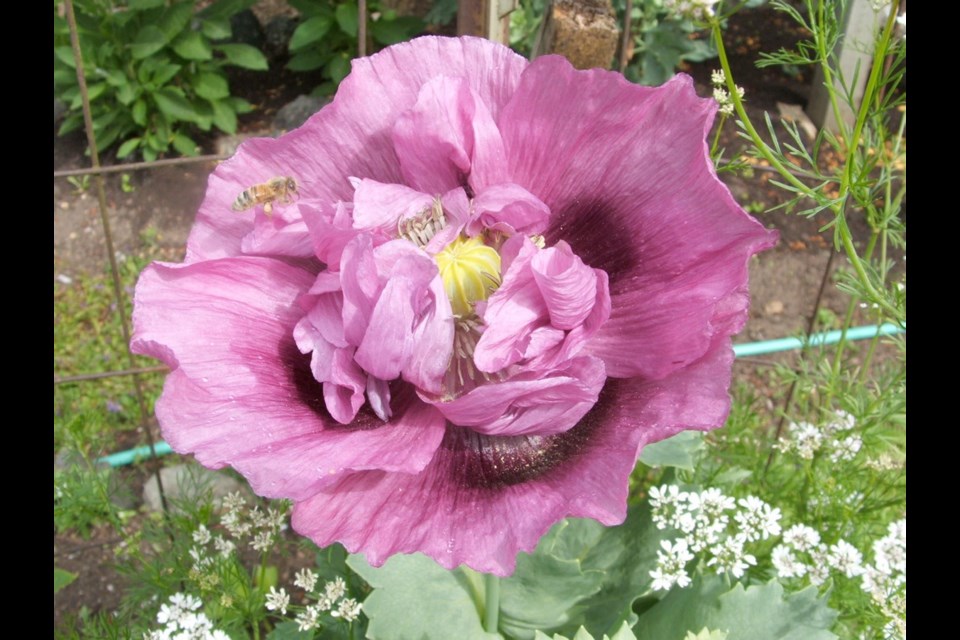When I’m in the garden, the poem Leisure, by W.H. Davies, often comes to mind: “What is this life if, full of care,/ We have no time to stand and stare?” It reminds me to slow down enough to notice small plant and flower scenes that present themselves from time to time in the garden.
I’m thinking of a lacy wild arugula plant at an edge of a vegetable plot this spring, a dainty ruff of white sweet alyssum blooming around its base. Both plants self-sow freely in my garden.
Several years ago a donkey-tail spurge appeared beside the greenhouse door. I cut back the flowered stems in summer to retain the evergreen plant’s neat form as its blue-green, succulent foliage peeks out of a companion (volunteer) carpet of bigroot geranium.
To keep that plant duet conveniently compact, I occasionally pluck out tufts of the geranium and pass them along to a neighbour who is establishing a mass planting of the weed-suppressing ground cover.
And the tall, flamboyant peony poppies are back in abundance this year — in beautiful coral and peach shades, white and pink, lilac, and one with finely fringed, burgundy-black petals. Most have fully double, frilly flowers. The smooth, blue-green leaves have wavy edges.
These poppies (Papaver somniferum) are welcome points of dramatic colour throughout the garden, and the dried pods yield seeds that can be used in baking. For that reason they are called breadseed poppies. The plants are frequent “volunteers” in gardens.
Early in the month, beside the cucumber vines, I found a lovely lilac poppy blooming together with the lacy flowers of cilantro. For a while I stationed myself in front of the bloom, watching a bee darting in and out of it. As I stood there, a hummingbird arrived to whir away at my right elbow for a while before darting off.
Gardens. Places to pause, and allow delight to happen.
July pruning. I aim to prune wisteria, kiwi and grape vines, and fruit trees this month. Summer pruning of fruit trees helps to keep them compact, while “dormant season” pruning in late winter promotes an abundance of new growth.
On my apple trees, I shorten the new growth back by at least a half, often leaving just three or four leaves on that new, lighter-coloured growth. Cut right above an outward-pointing leaf, to direct new growth away from the centre of the plant.
At the same time, remove any dead, broken or awkwardly positioned growth. Ideal is an uncongested tree that allows free circulation of fresh air and optimum exposure of ripening fruit to sunlight.
Shorten new growth also on kiwi and grape vines. I make the cuts just a few leaves beyond forming fruit. On both vines, opening up “windows” of sunlight onto the developing kiwi fruit and grape clusters helps to promote their development and ripening.
On wisteria, shorten the long shoots of new growth to between 10 and 15 cm. Cut main, framework stems back where they have grown beyond the vine’s support structure. Prune again in January, leaving three or four buds on shoots produced since the summer pruning.
Cats, revisited, with bells on. In a recent column I shared my adventures chasing neghbours’ cats away to protect quail families making their way through the garden. The last time I ran after beefy Blaze as he headed for his home fence, I rounded a corner too fast, slid on a rock pathway edging, and toppled over onto a large, cushy clump of chives. I was fine. The chives, not so much.
It appears I’m not alone in attempting to foil the felines. Jean has written: “We have also had a problem with cats. We used to see the quail all the time and now never do. The neighbours’ cats do have bells, but they (the cats) soon learned to walk in a way that keeps the bells silent.”
Another reader admits to “having a serial killer of a cat.”
In search of a solution, she “talked to the staff at Wild Birds Unlimited, who advised me that birds are highly colour sensitive. On their recommendation my cat now wears a very bright fabric clown-style ruff. Now, she is catching one bird a month at most, compared to one almost every day.”



